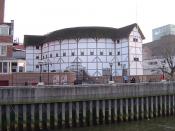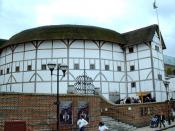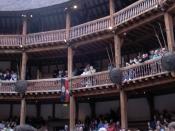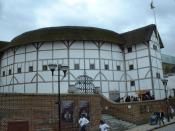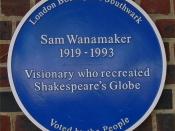The globe theatres then and now are very different but yet they are very alike. The new globe was built to resemble the old globe theatre. It's shape and structure sometimes scare people because of the resemblance. But still the new theatre cannot bring about the past traditions and memories that the old theatre provided the people.
In 1597, Cuthbert Burbage inherited a London theatre that was the first of its kind and simply called the theatre. The theatre was torn down then rebuilt with its own timber and other elements as the building materials for what would become the Globe theatre. The old Globe Theatre was built 1599, the theatre held up to 3,000-seated spectators. The globe had 20 sides which made it appear round, it was three stories high and had no lighting, the diameter of the theatre was about 100 feet, and it was also an open aired theatre, which means that the Globe had no roof, due to it having no roof all performances were weather permitting, and during the day, between 2 P.M.
and 5 P.M. The theatre was divided into three sections. The bottom, which was called the "pit", where mostly all lower class people gathered, it was only a one penny admission to enter the "pit". The second level consisted of more civilized and orderly people, the price was two pennies, and finally the upper level where chivalry gathered and higher ranked officials. Burbage mainly built the Globe for the Chamberlain's Men, including their chief writer William Shakespeare. Cuthbert Burbage couldn't build the theatre if it wasn't for William Shakespeare and other famous writers, without writers the theatre would be worthless. The original structure of the theatre stood until the 29th of June 1613, when a cannonball was fired during a performance of Henry VIII, the cannonball ignited a blaze and the whole globe was burned to the ground. The Globe was reconstructed in 1614. However in 1642 twenty-five years after Shakespeare's death, the Puritans closed down the theatre, and mostly all of England's theatres to make housing.
After an absence of 400 years from London's theater scene, Shakespeare's Globe rises again on the South Bank of the Thames River. The New Globe Theatre is not a perfect reproduction of the original Globe theatre. It is made from new green oak. New additions where made to satisfy fire safety regulations. These entitled making the stairways and access doors wider, positioning sprinklers valves on the top of the now featured roof, new electrical lighting and filming were installed along with an increased audience capacity of up to 1,400. The new Globe theatre could have not been built without Sam Wanamaker. In 1970 the American actor Wanamaker established the Shakespeare Globe playhouse trust site in 1949, just 200 yards from the first Globe site. A decades-long battle for funds followed, later it was finally resolved by a British National Lottery grant. Even though the plays were staged much the same way as when Shakespeare's troupe produced them, the difference between them are largely acknowledged.
The new theatre takes people through a trip to the past, a trip to the Shakespearean era, it teaches us how life back then was, and even though it is not a fully accurate structure, it still provides us with a vision to the past. The new globe is much alike the old one in many ways, in that both do not have sets, or spotlights. One thing that took me by surprise was the recognition that the new globe does not consist of any microphones, just like the old one, plays must be shouted aloud so that now the more larger and vast crowd can hear the lines of the actors.
As we can see, the Globe theatre of the past provided us with much joy, laughter, and entertainment for all types of people, from lower class, to chivalry. And to think about it, without the upbringing of the Globe close to 200 years later, all those fun memories and excitement of the past would have been forgotten. So we thank Burbage family for building such a wonderful structure, and we thank Sam Wanamaker for keeping it alive.
